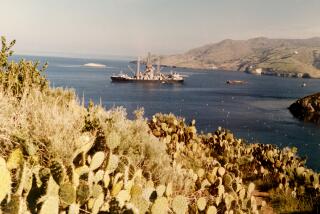‘U-571’ and the Battle Over the Roles Each Navy Played
- Share via
So “U-571” director Jonathan Mostow “incurred the displeasure of her majesty’s navy” by using Americans to capture an Enigma machine on a German sub (“WWII at Sea, as Fought on the Screen,” by Lawrence Suid, April 25). This is somewhat hypocritical, since films about the British navy have been especially reluctant to acknowledge the efforts of her allies in World War II.
Norwegian resistance in the sinking of the Bismarck and Tirpitz, and the part Americans played in Ultra secrets and radar development, have been, if not ignored, severely downplayed.
TROND WOXEN
North Hollywood
*
How times change. In 1941, it was a British destroyer that captured an Enigma decoder from a Nazi U-boat. The “U-571” filmmakers have acknowledged the British feat. The Brits are happy. The British sailor who pulled the Enigma machine from the sinking German sub serves as a consultant. Well, OK.
Not so in 1945. The American film “Objective, Burma!” was withdrawn in London after objections that it exaggerated American participation in Burma and disregarded British achievements.
VAL RODRIGUEZ
Signal Hill
*
I’m not sure why the producers of “U-571” happened to pick this particular designation for their fictitious U-boat, as there was a real U-571 in World War II.
The sub was of the class VIIC, built in the Blohm & Voss Shipyards, Hamburg, Germany, and commissioned May 22, 1941. U-571 had a total of 11 patrols, successfully sinking seven ships and damaging another. The sub never suffered a single casualty until it was sunk Jan. 28, 1944, by an Australian aircraft in an area west of Ireland. All 52 hands were lost.
In the interests of historical accuracy, information like this is available on every German U-boat ever built at https://www.uboat.net.
JEFF BLYTH
Glendale
*
As a former sailor who served for 25 months aboard a Buckley-class destroyer escort in the South Pacific during World War II, I found the article very interesting. I agree wholeheartedly that “perhaps the best U.S. Navy movie of all time” is “The Enemy Below.” There were no phony heroics in that movie. The acting was superb! When I watched that movie, I was right back aboard ship again, reliving moments that occurred over 55 years ago, moments that are seared in my memory.
However, I do have a slight bone to pick with the reference to the “destroyer” that plays a pivotal role in the movie. The ship that Robert Mitchum skippered was a Buckley-class destroyer escort. For those who might be interested in learning more about these ships and the role they played in helping to win World War II, I would recommend “The Buckley-Class Destroyer Escorts,” published by the Naval Institute Press.
FRANK LEVIN
Encino
*
It seems incredible that a knowledgeable producer would deliberately sabotage the dynamic thrill element of his mega-action motion picture. But there it is right before my eyes on a behind-the-scenes television entertainment program: Watch how the ominous waves are created by wooden blocks. See how the incessant rainstorm batters the helpless men. (Not to worry, it is created by carefully calibrated overhead sprinklers.) Studio tanks, miniature submarines, all proudly shown.
There is no denying that the artists who put these incredible effects together deserve recognition--but among themselves. Movies are magic! Movies are real!
Does God explain his creation? Never in a million years. That’s why there’s so much order in the universe.
BILL PUGSLEY
Hollywood
More to Read
Only good movies
Get the Indie Focus newsletter, Mark Olsen's weekly guide to the world of cinema.
You may occasionally receive promotional content from the Los Angeles Times.









